
Evergreen plants, such as holly, pine, and cedar, offer year-round foliage, creating essential habitats for various wildlife. These plants not only provide shelter from harsh weather conditions but also serve as nesting sites for birds and small mammals. The dense branches of evergreens act as a protective barrier against predators while maintaining humidity levels that benefit surrounding flora. You can enhance your garden's biodiversity by incorporating a variety of evergreens, which will attract pollinators and beneficial insects. The resilience of these plants throughout changing seasons makes them a vital component of any sustainable landscape.
List of some Evergreen plants that provide shelter
- Holly (Ilex)
- Boxwood (Buxus)
- Laurel (Laurus)
- Juniper (Juniperus)
- Cedar (Cedrus)
- Pine (Pinus)
- Spruce (Picea)
- Yew (Taxus)
- Fir (Abies)
- Cypress (Cupressus)
Important things about Evergreen plants that provide shelter
Year-Round Foliage
Evergreen plants, such as Holly, Arborvitae, and Spruce, maintain lush foliage throughout the year, making them ideal for providing shelter in your garden or landscape. These hardy species offer a protective barrier against harsh weather conditions, while their dense leaves provide habitat for various wildlife, including birds and insects. The year-round green foliage not only enhances the aesthetic appeal of your outdoor space but also contributes to privacy and noise reduction. By incorporating evergreens into your landscaping design, you create a sustainable environment that supports both beauty and biodiversity.
Wind Resistance
Evergreen plants, such as holly and yew, serve as effective natural windbreaks, reducing wind resistance and creating sheltered microclimates in your garden. Their dense foliage traps wind and minimizes its impact, protecting surrounding plants and structures from potential wind damage. Moreover, the year-round greenery of these plants enhances visual appeal while providing habitat for local wildlife. Incorporating evergreens into your landscaping can improve energy efficiency by lowering heating costs through wind protection.
Privacy Barriers
Evergreen plants such as Arborvitae, Boxwood, and Leyland Cypress are excellent choices for creating privacy barriers in your landscape. Their dense foliage and year-round greenery provide not only visual protection but also sound insulation, enhancing your outdoor privacy. In addition to creating a natural screen, these plants support local wildlife by offering shelter and nesting habitats. By incorporating evergreens into your yard, you can enjoy a more secluded space while contributing to biodiversity in your area.
Habitat For Wildlife
Evergreen plants, such as pine trees, holly, and fir, play a crucial role in providing shelter for wildlife throughout the year. The dense foliage of these trees offers protection from harsh weather conditions, serving as a refuge for birds, small mammals, and insects during both summer and winter months. In addition to physical shelter, evergreen plants often produce berries and nectar, attracting various species and enhancing biodiversity in your garden or landscape. By incorporating evergreen species into your outdoor space, you create a vital habitat that supports the local ecosystem and helps sustain wildlife populations.
Soil Stabilization
Evergreen plants play a crucial role in soil stabilization, offering protective cover that prevents erosion during seasonal changes. Their dense foliage not only shields the soil from heavy rain and wind but also enhances moisture retention, promoting healthier soil structure. By establishing deep root systems, evergreens stabilize the ground, effectively reducing sediment runoff and encouraging biodiversity in the surrounding ecosystem. Incorporating these resilient plants into your landscape design can significantly contribute to sustainable soil management and environmental protection.
Aesthetic Appeal
Evergreen plants, such as Hemlock, Pine, and Cedar, are invaluable for providing year-round shelter in gardens and landscapes. Their dense foliage not only offers a protective haven for wildlife but also enhances the aesthetic beauty of your outdoor space. These lush, green plants create a vibrant backdrop, contrasting beautifully with seasonal blooms and ground covers. Incorporating evergreens into your garden design can improve habitat diversity while ensuring visual interest throughout every season.
Low Maintenance
Evergreen plants, such as holly, juniper, and boxwood, are ideal for creating natural shelters in your garden due to their year-round foliage. These hardy plants not only provide aesthetic value but also serve as essential habitats for wildlife, offering protection from harsh weather conditions and predators. Planting a combination of evergreens can enhance biodiversity by attracting birds and beneficial insects, ensuring your garden remains vibrant and alive throughout all seasons. Incorporating these low-maintenance species into your landscaping can create a serene retreat while supporting local ecosystems.
Drought Tolerance
Evergreen plants like Juniperus and Pinus species are excellent choices for drought tolerance while providing year-round shelter for wildlife. These hardy plants have adapted to retain moisture, making them ideal for water-scarce environments. Their dense foliage offers refuge and nesting sites for various birds and small mammals, enhancing biodiversity in your garden or landscape. By incorporating drought-resistant evergreens, you can create a sustainable ecosystem that thrives even in challenging conditions.
Temperature Regulation
Evergreen plants, such as pine, fir, and spruce trees, play a crucial role in temperature regulation within their ecosystems by providing year-round shelter. Their dense foliage acts as a natural insulator, reducing heat loss during colder months while offering shade in the summer, which helps maintain a stable microclimate. Additionally, these plants can protect against wind and harsh weather, creating a more temperate environment for various species, including wildlife and understory plants. By incorporating evergreens into your landscape, you contribute to local biodiversity and enhance the climate resilience of your outdoor space.
Versatile Sizes And Shapes
Evergreen plants, such as holly, yew, and boxwood, come in versatile sizes and shapes, making them ideal for creating natural shelters in gardens or landscapes. Their dense foliage not only provides year-round cover but also serves as a habitat for various wildlife, enhancing biodiversity in your outdoor space. With various growth habits ranging from low-growing ground covers to tall hedges, evergreens can be strategically placed to block wind, reduce noise, and create private retreats. Incorporating these plants will not only beautify your environment but also foster a thriving ecosystem.
